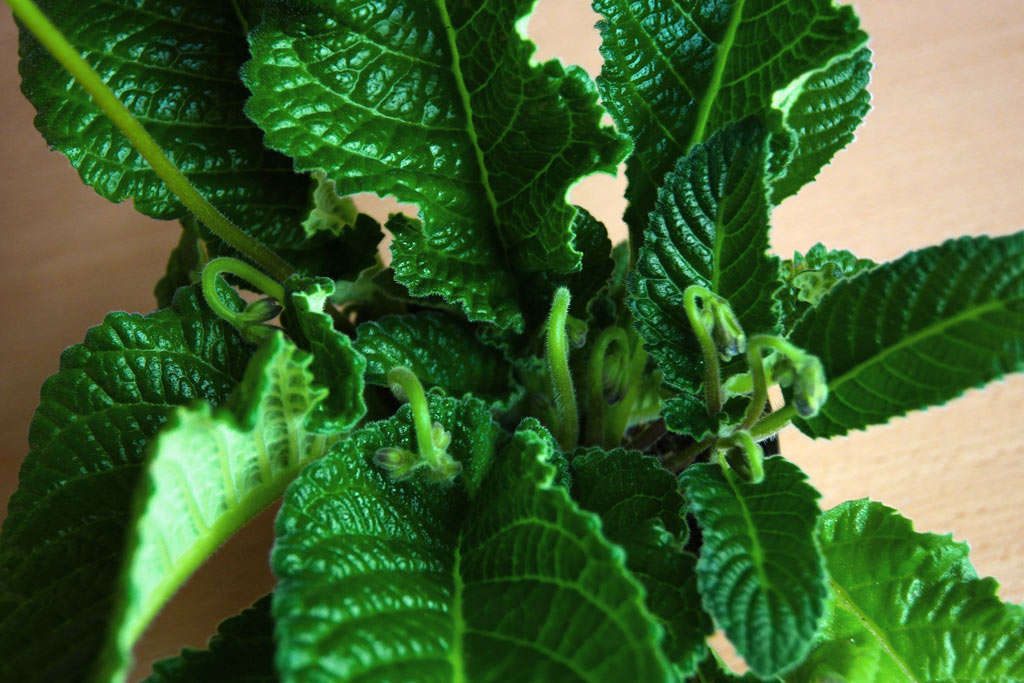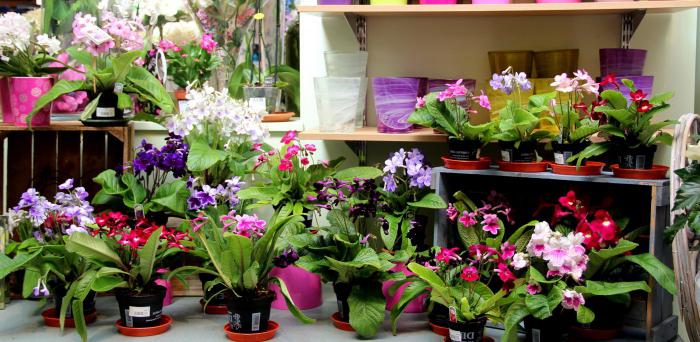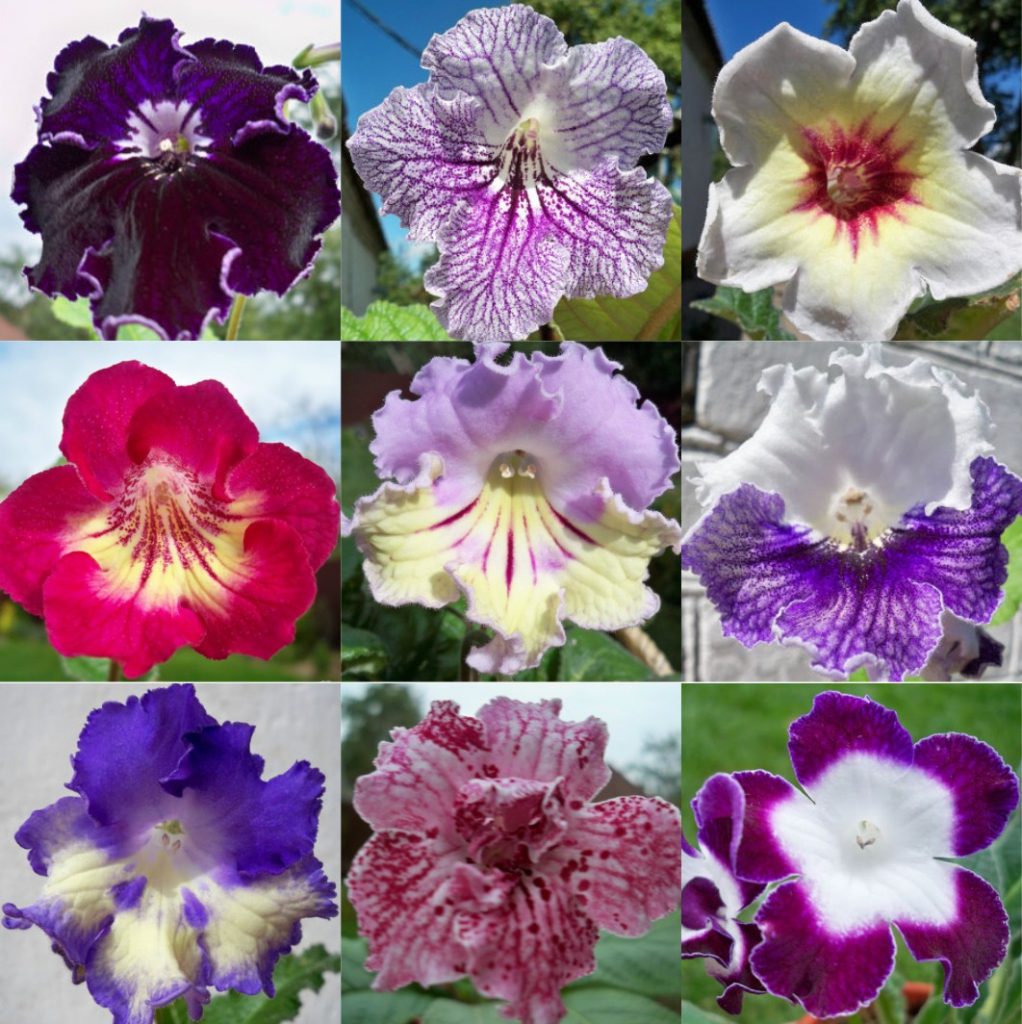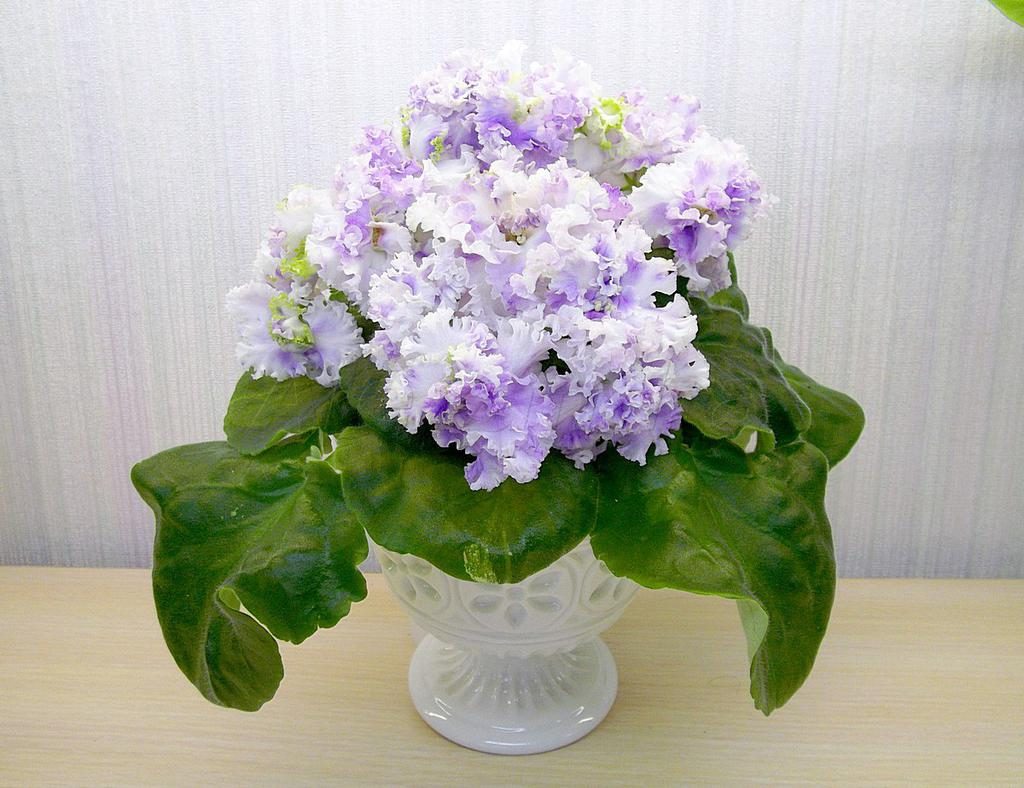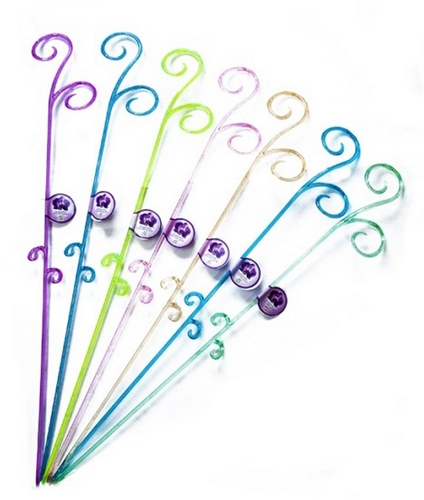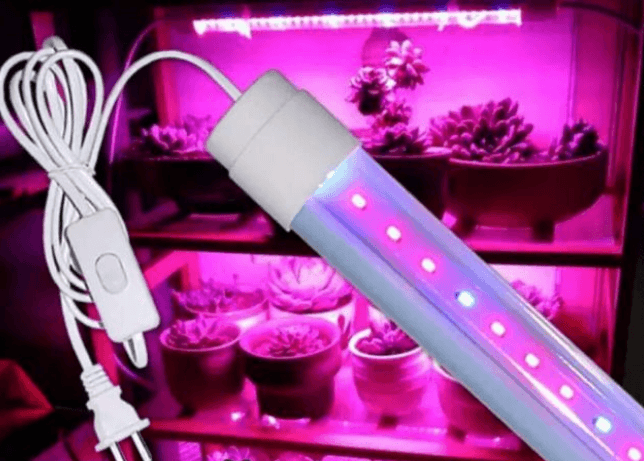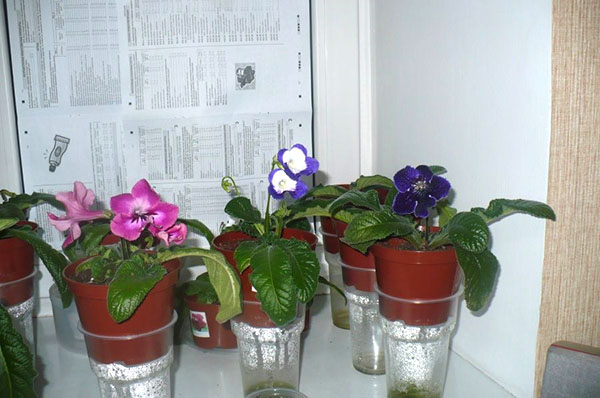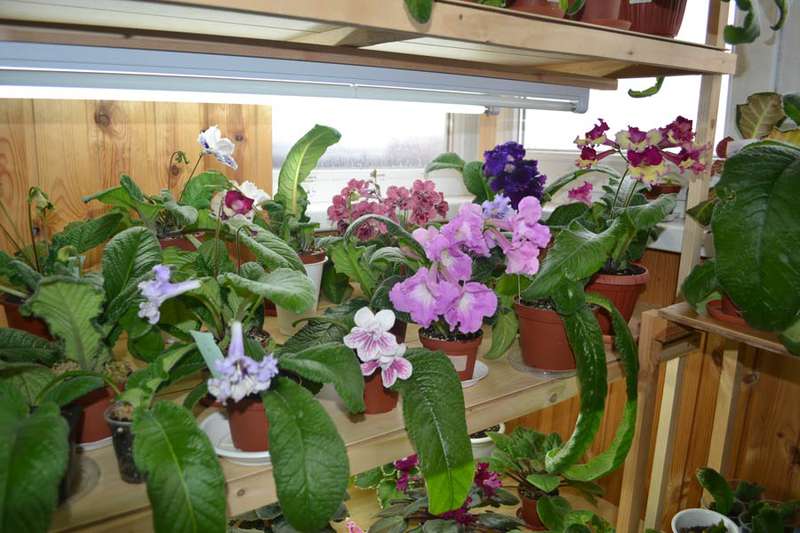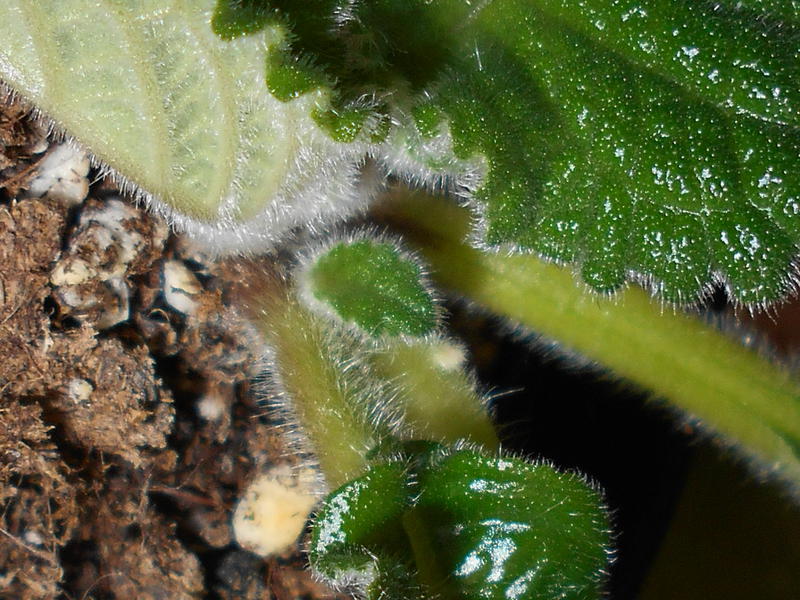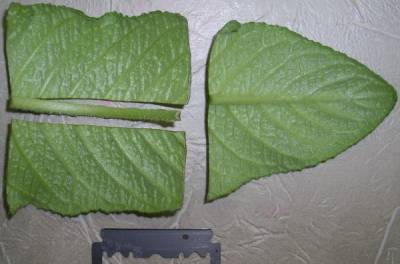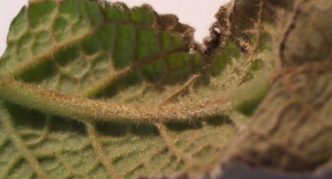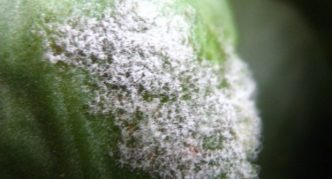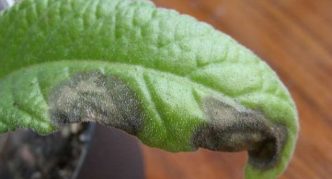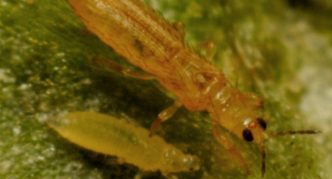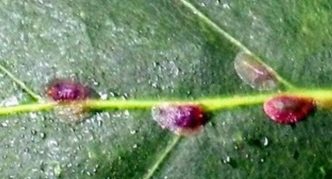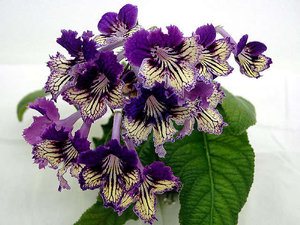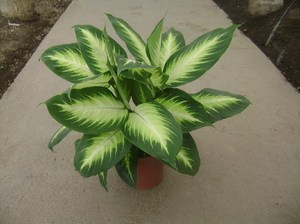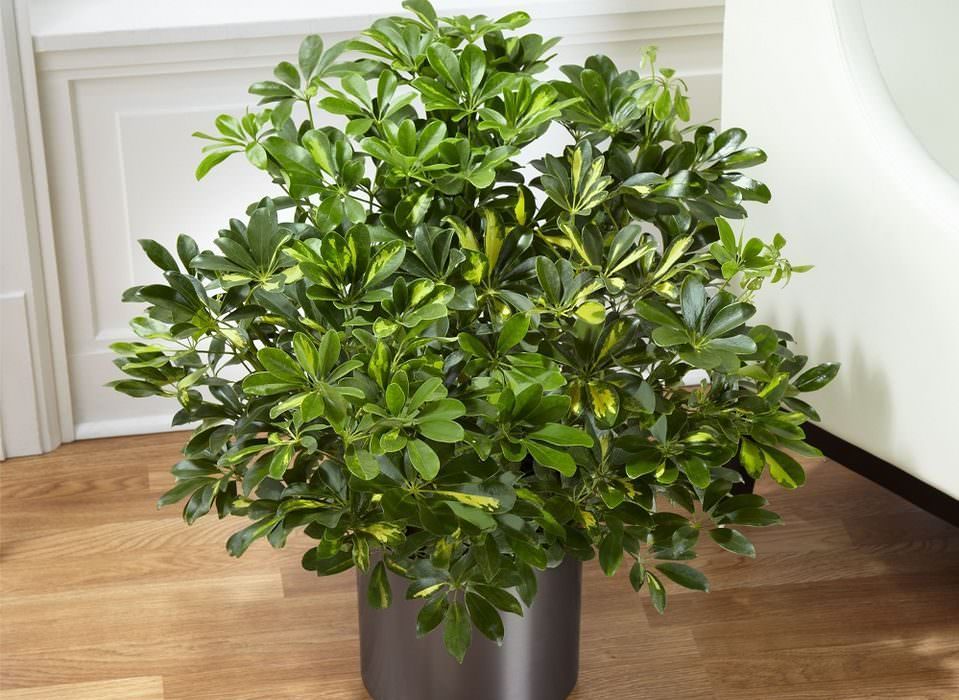If you see this unusually beautiful flower with a difficult to pronounce name for the first time, you get the impression that it is very demanding, like many flowering plants. This is a misconception. Growing and caring for streptocarpus (or simply straps - as many growers call them for short) does not cause much trouble, they are distinguished by their unpretentiousness, duration and abundance of flowering and a huge variety of colors and shapes.
Content
What streptocarpus look like
The natural habitat of streptocarpus growth is tropical and subtropical forests of the South African mountain slopes. They are located quite high above sea level and are characterized by the absence of high temperatures. In nature, there are about 130 species of this plant. They are less decorative than hybrid varieties bred by breeders.
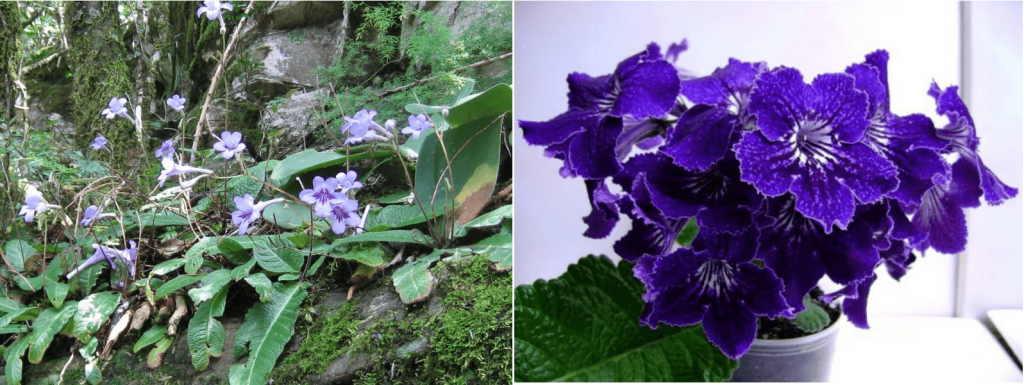
Left: Streptocarpus in its natural habitat. Right: Vendlen's streptocarpus bred by breeders, featuring one large leaf
Streptocarpus has no stem. The plant is a rosette of long fleshy leaves that are covered with soft fibers. Peduncles grow from leaf axils. One peduncle can produce several flowers, and elite varieties are distinguished by a huge (up to 100) number of flowers growing simultaneously on one bush. Streptocarpus flowers are shaped like bells with a diameter of 2 to 9 cm. Their color varies from white to purple, often different shades are combined in one flower, they can have specks and stains. Some hybrids have double leaves. The petals (there are always five of them) can be of various shapes with rounded or wavy edges.
The types of streps and leaves differ: their number, size and color. The fruit of the plant is a twisted seed capsule. Because of its shape, the flower got its name: streptocarpus is translated from Greek as a twisted box.

The size of the streptocarpus capsule depends on the number of seeds contained in it, as well as varietal characteristics
The first scientific description of streptocarpus was given by the English botanist James Bowie. He also provided the seeds of the plant to the London Botanical Gardens. It happened at the beginning of the 19th century.
In recent decades, streps has been rapidly gaining popularity among flower growers dealing with indoor plants. All of them note that the flower easily withstands various deviations from the recommended rules of care and blooms profusely.
Varieties
There are many varieties of blooming miracle, the most popular and beautiful are offered in article.
Flower transplant
Why do amateur flower growers distinguish streptocarpus among the huge variety of indoor flowers? The fact is that this plant has a lot of advantages compared to other abundant flowering exotics:
- flower care is simple, easy to grow;
- it blooms magnificently from spring to November;
- using additional lighting, you can admire the flowering of streptocarpus in the winter;
- flower reproduction is not difficult;
- the plant is distinguished by a rich palette of colors and a variety of forms.
A distinctive feature of streps is a well-developed root system, which quickly fills the volume of the flower pot, so the plants require annual replanting. It is preferable to do this in February, before the active growth of the flower begins.
If you have just purchased a flower, and it is planted in a small container, then give it a couple of weeks to adapt to new conditions, and then be sure to transplant, even if the streptocarpus blooms. It is recommended to cut off all peduncles before transplanting mercilessly so that the plant directs its forces to the development of the root system.
Landing capacity
A properly selected planting capacity for streps is one of the ingredients for good growth and lush flowering. A feature of the plant is the fact that its ground part develops poorly until the roots master the earthen lump of the pot, so the size of the container should be directly related to the age of the streps, the size of the bush and the state of the root system. When choosing, you need to pay attention to the following points:
- preference should be given to wide and low plastic pots. The fact is that the flower has many thin roots that penetrate the pores of the walls of clay containers, therefore, during transplantation, the root system of the plant can be deeply damaged;
- you should not choose high and narrow containers - it is impossible to achieve uniform soil moisture in them. With a dry upper layer of soil, the lower one will be still moistened, as a result, the roots of the plant will suffer simultaneously from an excess and a lack of moisture;
- each next flower pot should be 1–2 cm wider and deeper than the previous one;
- for young plants, you need to choose pots no more than 5–6 cm in diameter, for growing straps, a container size of 6–8 cm is suitable, and for adult plants - 12–14 cm;
- the use of containers with a diameter of more than 18 cm is undesirable, since excess moisture will accumulate in them and root decay may occur;
- When choosing a color, opt for light-colored pots that will prevent the root system from overheating in the summer heat.
For children of streptocarpus, it is recommended to choose transparent containers, for example, disposable cups. The roots of the plant are clearly visible in them, you can easily adjust the amount of water required for each flower.
Priming
The soil for the flower should have a loose structure, good air permeability and nutritional value. Store-bought soil for violets is quite suitable, which is recommended to be mixed with high moor peat.
If you decide to prepare the substrate for the plant yourself, you can use the following recipe:
- clay-sod land;
- peat;
- humus;
- coarse river sand.
These ingredients should be used in a 2: 1: 1: 1 ratio. It is useful to add fine charcoal to the soil mixture. It will prevent moisture retention in the soil, help to avoid rotting of the root system.
Any soil used, including purchased one, should be steamed for an hour in the oven at 180 degrees, or at least spilled with boiling water. Such a procedure will disinfect the soil mixture, kill all pests and the vast majority of pathogens.
Transplant process
If the transplant of streptocarpus is carried out correctly and in a timely manner, then the flower responds very well to it, begins to grow actively, and blooms quickly. Some Internet sources recommend using the transshipment method when transplanting streptocarpus, that is, transplanting with a lump of earth. Considering that the root system of the flower develops quickly, the flower has already taken away all the nutrients from the old soil, it is more effective to completely replace the substrate when transplanting. Of course, some of the roots will be damaged in this case, but in most cases new roots grow without problems, thereby rejuvenating the root system and the plant itself.
The transplant process is carried out as follows:
- At the bottom of the selected container, a drainage layer of expanded clay, pebbles, small clay shards is organized.
- A prepared soil mixture is poured over the drainage layer. If the substrate is pre-moistened, then after transplanting the plant, watering is not performed.
- Gently remove the streptocarpus from the old pot. Before this, the plant is not watered, so that it is better and easier to remove the old soil.
- If necessary, divide the bush into several divisions. The wounds are treated with activated charcoal, greenery and slightly dried.
- The remnants of the old substrate are removed from the roots. Damaged and too long roots are cut off.
- Damaged and too long roots are cut off.
- The plant is lowered into a pot and sprinkled with soil mixture, making sure that the growing point remains above the surface of the substrate, and the young leaves are not buried in the ground.
- Slightly squeeze the ground around the bush so that there are no voids left.
- Cut off old, damaged leaves, peduncles. It is recommended to shorten large young leaves by half.
- Surface watering is carried out if necessary.
- Cover the flower with a plastic bag to create a greenhouse environment. Remove the shelter after the first new leaf appears.
The first two weeks after transplanting, the upper watering of the plant is used, and then the lower one: in the pan or through the wick.
Video: we transplant streptocarpus correctly
Support for peduncles
Depending on the variety, streptocarpus can have high (up to 25 cm) or short flowering stems. Most often they are strong, resilient and stable, capable of supporting the weight of large flowers and not falling. In some plant varieties, peduncles are weak, they hang in a cascade. If necessary, a support device should be inserted into a pot with such a plant already during transplantation. These can be simply self-made wooden sticks, to which the peduncle is neatly tied, or commercially available flower holders, including those for orchids.
Features of streptocarpus care
For all its unpretentiousness, the flower requires a certain amount of attention.He is a child of the tropics and subtropics, therefore he is thermophilic. Comfortable temperature for straps is the usual room temperature of + 20-25 degrees. The flower does not like heat and does not tolerate well. In winter, when the plant is at rest, the temperature can be reduced to +14 degrees.
Please note that the flower will not tolerate temperatures below +12.
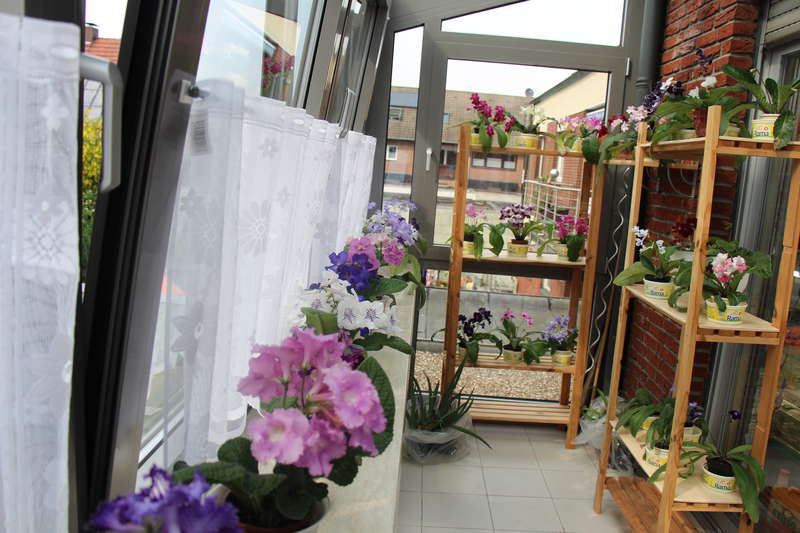
Like many plants, streptocarpus does not like drafts. If in the summer you send a flower to a glazed loggia or balcony, then it is recommended to cover the sash of the windows at night
Good and correct lighting is an important condition for long and abundant flowering. Daylight hours for the streps should be 12-14 hours, while the light falling on the plant should be diffused. In the summer, it is better to send the pot to windows oriented to the west or east, since on the south side for streptocarpus it will be necessary to create shading from direct sunlight.
If a flower is placed on the north side of the house, then it will constantly experience a lack of light.
You can create comfortable illumination for a straps anywhere in the house, even in the back of the room, if you use special phytolamps for illumination. Traditional incandescent lamps are not suitable for this purpose, as they emit too much heat, they have poor light output and there is no ultraviolet radiation. Luminescent, that is, conventional energy-saving ones, are also not suitable, primarily because of the luminous flux. Even conventional LEDs have too little emission at the edges of the spectrum. The best option is special phytolamps for plant illumination. Their main drawback is their decent cost. But the advantages of special lamps are much more:
- they are economical;
- durable;
- safe;
- environmentally friendly;
- compact;
- have uniform radiation, which allows you to effectively focus the flow of light on the culture;
- contain spectra useful for plants in the luminous flux, accelerating photosynthesis.
Watering
Very often, failures in growing streptocarpus are associated with improper soil moisture. If the plant is forgotten to water, then its leaves will quickly restore elasticity as soon as they receive moisture. True, the drooping flowers will have to be cut, they are lost. If the flower is excessively moisturized, then it can become seriously ill and even die. Most hybrids have few leaves, they evaporate little moisture, so the plants should be watered sparingly and only with settled water. Watering can be done in various ways:
- into the pallet;
- along the edge of the container so that water does not fall on the leaves;
- with a wick. This is the most effective watering for streps, since the constant capillary supply of moisture makes the soil stable, but moderately moist.
The plant does not feel well with increased dry air, therefore it is appropriate to periodically spray the area around the flower, but not the plant itself. Moisture entering the axils of the leaves can cause stains on the leaves, diseases and rotting of the streps. You can put a container with water or moistened expanded clay next to the flower.
Food
In order for the plant to actively develop and bloom, it must be provided with the necessary nutrition. The flower quickly assimilates the substrate in the planting container, selects all the nutrients from it. If you do not feed the straps, then it will begin to wither and hurt. For normal growth and development, the culture needs nitrogen, potassium and phosphorus. Nitrogen-containing fertilizers are needed to build up green mass, and potassium and phosphorus are needed for stable and lush flowering.
Immediately after rooting, nitrogen fertilization is recommended. They can be carried out weekly until the appearance of peduncles.From ready-made preparations, you can use Florist-growth. Further, it is better to apply complex fertilizers for flowering indoor plants: Flower Waltz, Master, Kemira-Lux, etc. They will ensure the abundance of flowering, brightness and color saturation of flowers. The ideal option would be to alternate between different formulations.

Ready-made preparations contain a balanced set of nutrients necessary for the full growth and development of floral and ornamental plants
In order not to harm the plant, not to overfeed it, experienced flower growers advise using half the dosage indicated on the package for feeding.
To fertilize streptocarpus, you can use folk remedies, alternating with complex preparations. Here are some simple options for such feeding:
- 1 tbsp. Dissolve a spoonful of sugar in 0.5 liters of water. Top dressing with this solution can be carried out once a month;
- 3 tbsp. insist tablespoons of wood ash in 1 liter of water for a week. Watering frequency - once every two weeks;
- Add 1 teaspoon of castor oil to 1 liter of water. Water during the budding period.
Plant feeding is carried out only in the phase of active growth and flowering. If the plant is set to rest. then feeding is not carried out.
Periods of flowering and rest at home
Streptocarpus begins to bloom in the spring and ends in late autumn, and with sufficient light, they can bloom in winter. They do not have a pronounced rest period. With a reduction in daylight hours, if the plant is not provided with additional illumination, the streps slow down growth, cease to produce flower stalks, and plant buds. At this time, you can start transplanting a flower, carry out sanitary cleaning, which consists in removing old leaves, stepchildren-rosettes. Sometimes the plant sheds its leaves by itself.
During the rest period, the flower pot can be left on the windowsill. Streps easily tolerates low temperatures (up to +14 degrees), calmly reacts to drafts. It is worth protecting the flower from the hot air of heating. Watering the plant at this time should be moderate. Top dressing in winter is unnecessary.
If your streptocarpus live on backlit shelving, they will bloom in winter. True, flowering will not be as lush and abundant as in spring or summer. Please note that some straps varieties do not bloom in winter, even with additional lighting. If you are planning to create a small winter garden of flowering plants, then carefully study the characteristics of the variety and select suitable hybrids.
Experienced flower growers advise sending the plant on a winter vacation so that it can accumulate strength for a new flowering season.
In the autumn period, baby streptocarpus often bloom. If you want to have a strong and healthy streps bush in the future, it is better not to let them do this. At best, leave one flower to see its shade and shape, and trim the rest. Flowering requires a lot of strength from the plant, so sometimes young plants that bloom in winter simply die.
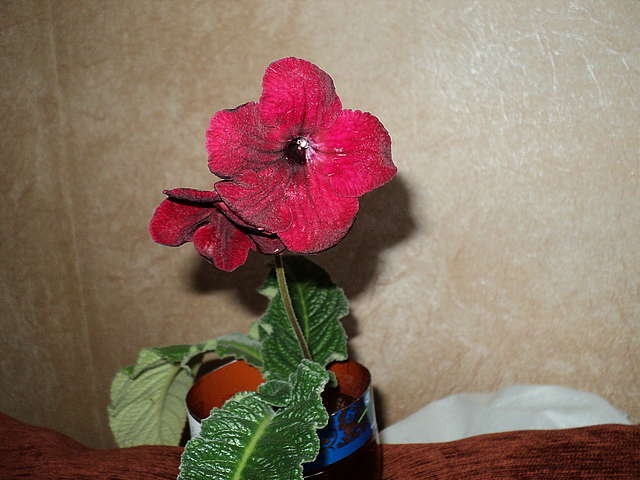
Experts note that the earlier the baby of streptocarpus blooms, the more willingly and abundantly this variety will bloom for adults.
Natural active growth of the flower begins in February, with an increase in daylight hours. If you did not transplant in the fall, then be sure to do it at the end of the dormant period. Until about May, the plant will gain green mass, and then it will begin to form buds. After the end of the flowering period, it is recommended to cut off all dry peduncles from the streps. It is important to do this with a sharp instrument, and not to pull out or break off the shoots. To prevent the plant from wasting nutrients on old leaves, it is also recommended to remove them.
Careless removal of dried flower stems and old leaves can damage dormant flower buds.
Table: conditions necessary for streptocarpus, depending on the season
| Top dressing | Lighting | Humidity | Temperature | Watering | |
| Spring | Weekly liquid fertilizing with a predominance of nitrogen component | Diffused lighting. Window sills facing east or west are best. In a south-facing room, the pots should be placed on a shelf or table. The plant should not be exposed to direct sunlight | From 55% to 75%. At low humidity, additional spraying or placing containers with wet pebbles, sphagnum, or water next to the flower | + 20-25 degrees | Moderate |
| Summer | Phosphorus-potassium complexes for flowering indoor plants | ||||
| Autumn | The plant is fed with a phosphorus-potassium complex until the end of flowering | Window sills facing the south side of the house. If the flower is on a north-facing window, then it will need additional lighting | |||
| Winter | If the plant is sent to rest, then feeding is not carried out | + 15-20 degrees | If the plant is sent to rest, then the minimum |
If streptocarpus does not bloom
If the flower is sufficiently developed, its leaf rosette is impressive, and flowering does not begin, then most likely the problem is associated with the incorrect content of the streps. In this case, it is recommended to pay attention to the following points:
- the plant receives less sunlight. Move the pot closer to the sun, avoiding direct rays;
- the soil is excessively moist. Perhaps the roots of the flower have begun to rot. In this case, you need to urgently transplant the straps, after cutting off all diseased and damaged roots;
- the flower lacks nutrients. Flowering is a process that requires a lot from the plant, which it receives from the soil. Feed streptocarpus with complex mineral fertilizers;
- the bush is too thickened. Sometimes at the base of the leaves, not peduncles appear, but small leaves. They must be removed, since they prevent the development of flowering shoots, can quickly fill the space in the center of the bush;
- insect pests slow down the growth of the plant. If, upon visual inspection, you find unwanted guests, then the bush must be quickly treated with folk remedies or chemical preparations;
- too large landing capacity.
Flower propagation
There are many simple and effective ways to reproduce streptocarpus:
- dividing the bush;
- seeds;
- sheet.
Reproduction by dividing the bush
Streptocarpus grows quite quickly, and by the end of the season several divisions with a common root system are formed in the pot. It is not difficult to get several full-fledged bushes from one plant:
- The bush should be well moistened and removed from the soil.
- Shake off the ground and use a sharp tool to cut the bush into pieces. Each division should have several leaves. Large leaves can be shortened or removed altogether. This will stimulate the growth of young leaves and promote the fastest rooting of the plant.
- Damaged, dead roots are cut off. The cut site must be dried and sprinkled with ash or a crushed activated carbon tablet.
- The prepared cut is placed in a pot, filled about 2/3 with drainage material and soil substrate.
- The newly formed part is sprinkled with soil up to the root collar. The soil mixture is lightly tamped, making sure that no voids are formed in it.
- The soil is watered with warm water.
- The planted cut is covered with cellophane, creating a kind of mini-greenhouse. In such conditions, streptocarpus will take root faster.
This method allows you to quickly and inexpensively get at least two new plants from one plant.
Video about this method
Sheet plate
Most often, this method is used in the event that you have obtained one leaf of the desired variety for your collection. It is best to start this procedure in the spring. The leaf can take root in water. For this, the lower part of the sheet plate is sharpened and placed in a container with water. A significant disadvantage of water rooting is frequent leaf decay.
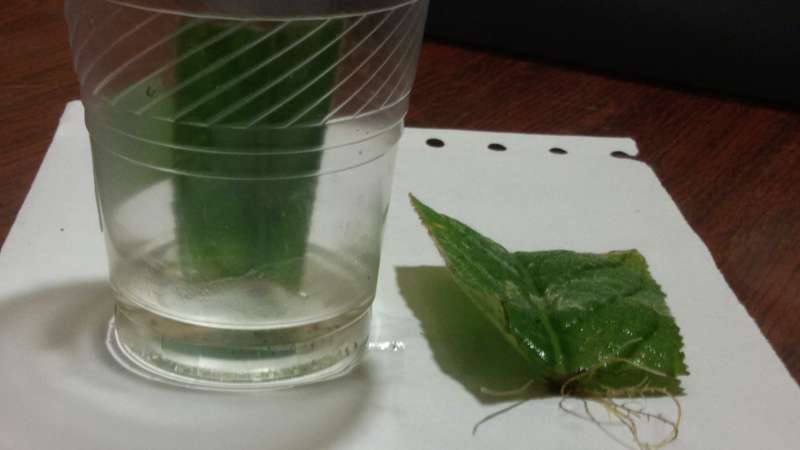
A little water is poured into a container, a fragment of a leaf is placed in it and a good root system is formed.
It is much more effective to root a leaf blade in a soil mixture for violets by adding vermiculite and peat to it:
- The leaf is removed from the plant.
- Using a sharp instrument, cut the leaf blade into fragments 3-5 cm wide. The lines of the cuts should run perpendicular to the central vein, which is recommended to be excised.
- The fragments are powdered with chopped charcoal and left to dry for 5 minutes.
- Then the longest part of the cut is planted in the ground, deepening by 5–6 mm. Pieces of leaf can be planted at a distance of 3-4 cm from each other.
- It is recommended to treat the planting with a fungicide, and then cover it with transparent material to create greenhouse conditions.
The container with the planted fragments must be placed in a room with a temperature of + 20-22 degrees. The bag should be removed daily and the planted leaves should be ventilated. Water the soil very carefully. If waterlogging is allowed, then the planted fragments can rot.
In the early days, the planted parts of the leaf plate may wilt slightly, but during the rooting process they will straighten and have a fresh appearance.
After about two months, babies are formed in the area of the cross veins. When young plants reach two to three centimeters in size (this will happen in another 1.5-2 months), the insulation is removed and the young are transplanted into separate containers.

The baby of streptocarpus often consists of only one leaf with roots, but she is already quite capable of living independently
Seeds
This method is very simple, but it only guarantees that you get young seedlings with signs of the mother plant if you purchase seeds from a specialized store.

Producers offer a huge selection of seeds of various varieties of streptocarpus at affordable prices
When sowing self-collected seeds, the result will be unpredictable. Most indoor streptocarpus are hybrids, so they are able to retain varietal traits only when propagated in a vegetative way. It is best to sow streptocarpus seeds in early spring. Since the seeds are very small, they are evenly scattered over the soil surface.
Important! Seeds sprout in the light, so they cannot be covered with soil.

If you have too many seedlings sprout, you simply cut out the extra specimens, leaving the strongest of them to grow.
After sowing, the seeds are carefully sprayed with water from a spray bottle, then the pot is covered with glass or other transparent material to create a greenhouse effect. Periodically, it is removed for a short time to ventilate the planting. Seedlings will appear 5-9 days after sowing. They can be thinned out, and when young streptocarpus reach a height of 2-3 cm, they can be transplanted into separate pots.
Experienced growers advise diving small seedlings, and several times before transplanting to a permanent place.
The first pick is recommended to be carried out about a month after the emergence of shoots. The sprouts are still very small, so they can be transferred to a new place of residence using tweezers or an ordinary toothpick. If the seedlings are not thickened, then the pick can be carried out in the same box in which they emerged.
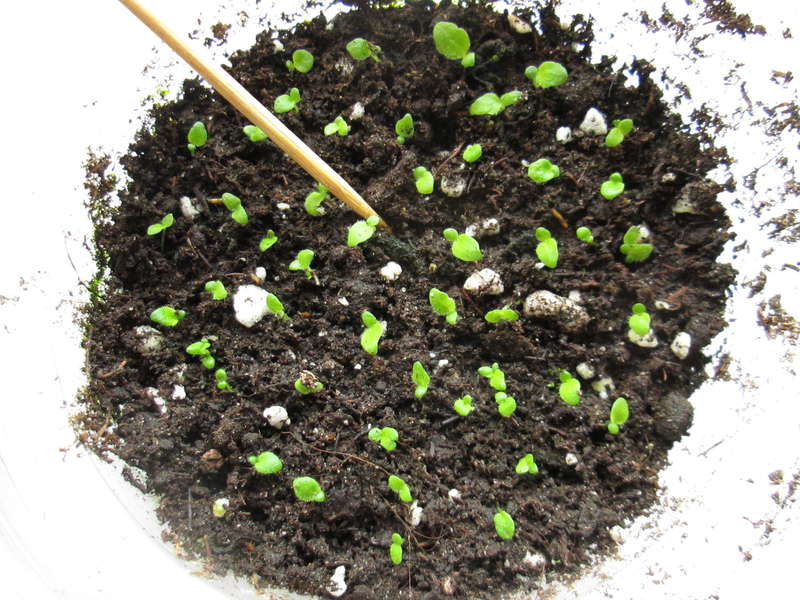
Florists advise to make the first pick as soon as it becomes possible to pick up a plant with a toothpick or a drawing pen
From sowing seeds to the beginning of flowering streptocarpus obtained in a similar way, it takes at least 8-9 months.
Video: picking streptocarpus seedlings
Problems when growing streptocarpus and ways to solve them
If your streptocarpus stopped growing, the leaves became lethargic, lost their elasticity, the long-awaited peduncles do not appear, the plant does not respond in any way to watering and changes in illumination, then most likely the flower is affected by some kind of disease or pest. With a close examination, streptocarpus problems are easily diagnosed and the flower quickly responds to competent treatment.
Fungal diseases affect indoor flowers, including streptocarpus, if the basic rules for caring for the plant have not been followed:
- watering exceeded the norm;
- the air temperature was lower or much higher than required.
To prevent infection of the flower, it is necessary, in addition to observing the basic rules of care, to regularly carefully examine the plant, to prevent crowding, thickening of the bush, and regularly ventilate the room.
Table: main diseases and pests
| Name | Signs of defeat | Control measures |
| Diseases | ||
| Powdery mildew | Part of the leaf, petioles are covered with a thin white coating, flakes, under which wounds and sores appear |
|
| Gray rot | The appearance of brown spots, and then a fluffy coating on any part of the plant |
|
| Rot of roots, stems and petioles | The appearance of brown spots, darkening of the petioles, loss of turgor by the leaves |
|
| Pests | ||
| Spider mite |
|
|
| Thrips |
|
|
| Shield |
|
|
Pests and diseases in the photo
- Rot can be triggered by fungal infections or excess moisture in the soil
- Fungus spores are often harmlessly present in a variety of soils for indoor plants, without manifesting or causing any harm until favorable conditions arise for them: low temperature about +15 degrees, high humidity 60-80%, poor air circulation
- The causative agent spreads through air, soil and infected plants
- Thrips are small arthropod insects 1-2 mm long, feeding on plant juices
- The body of the scale is covered with a two-piece plate, which is held together with a special wax secret
- One of the characteristic signs of leaf damage by a tick is a silvery sheen that appears due to air entering the leaves
The appearance of the plant will always indicate to the owner the presence of a problem in time, the main thing is to regularly inspect the plant and pay attention to its problems.
Table: outward signs of problems
| Problem | Possible reasons | Solutions |
| Wilting leaves | Drying out of the soil with insufficient watering | Normalize plant watering |
| Root decay with excessive watering | Transplant plant | |
| Yellowing of leaves |
|
|
| Drying of leaf tips |
|
|
| Does not bloom | Insufficient daylight hours | Install lamps for additional lighting |
| Spots on the leaves |
|
|
| Rusty coating on the leaves |
|
|
Video: amazingly simple and beautiful straps
Reviews of experienced growers for growing
a greenhouse is an indispensable tool for transplanting straps. Only then do not take it off abruptly, but slowly wean it, otherwise it will hang your ears again.
Old leaves, which can (and even need) to be removed, must be directly plucked (broken off, cut off) under the base. This applies to those sheets on which there were flower stalks, they are easy to see by the "stumps". On such sheets, anyway, it will no longer flourish, but they thicken the outlet, and interfere with the growth of new, young ones. And right now is the best time for this, while he is resting, so that by spring everything will be in openwork! I was also interested in watering. It turns out that streptas do not at all like layered moistened earth, like violets, for example. Water them only when the soil dries out, even a slight drooping of the sheets is allowed. This becomes especially important during the dormant period, in order to bloom beautifully and abundantly, they need to provide real peace!
If the streps is sick, it is urgently transplanted: the soil is taken slightly moist (I soak the peat tablet, squeeze it, add a little soil for Saintpaulias, perlite and crushed sphagnum, rub everything thoroughly between my palms so that the moisture from the tablet is evenly distributed between all the ingredients). I carefully shake off the roots of the streps itself from the old soil (I stir them up with my hands, fluff them up so that the soil is torn apart). I take the capacity by the volume of the roots, without a stock. Let it be better cramped than the extra soil not penetrated by roots. I compact the soil when planting quite a bit (it is better to add more after the first watering during shrinkage). And I do not water for 1-2 days, or even more (I try it with my finger for moisture). For the first time I water a sick straps with light potassium permanganate.If the straps have hung their ears, then I put it in the greenhouse, and if the cheerful one I don't cover it with a film. And one more thing: so that the roots breathe, I put the pot not in a flat pallet, but in a glass - a pallet, so that there is a space of 2 centimeters under the bottom of the pot (then the excess water flows down well during watering, and the roots breathe moist air - I don’t drain the water , but it doesn't touch the bottom of the pot). I also noticed that the streps really like it if they put the pot in the flowerpot - even if it is not tight, but then, probably, its own microclimate is created for the roots.
I'll tell you exactly how I did it. I just put the very young ones from a leaf or from a socket in a peat tablet almost half of it with perlite, in a 50g glass. Then, like the roots, they filled the entire space of the glass, put a disposable coffee mug into a mug, and added rotted cow dung there. I did this: drainage, then a little mixture of peat + perlite, then sprinkle it with dry manure, then again a layer of earthen mixture of peat + perlite, only then I planted the streps. With this method, the roots have time to develop without interference, as is known in the nutrient medium, they develop much more slowly, and then, the roots already find food for themselves (manure) and everything happens without damage to the root and the plant itself. But again, manure is only for healthy straps, and not for young animals !!! And it is necessarily rotted, not fresh.
and my only streptocarpus on a sunny window was burned, quickly lethargic and dried the peduncles. It grows well under artificial illumination and blooms willingly.
Streps like violets, gloxinia, pelargoniums and other plants with fluffy leaves should not be sprayed, since water settles on these velvet needles and is not absorbed by the leaf surface, a water lens is obtained and the plant receives a severe burn from the active sun. In addition, it can lead to decay.
It seems to me that it is not difficult to dive streptocarpus. I pry the seedling with a toothpick and press it into another dish with the same toothpick, without ceremony. Not one has died yet, they are tenacious
Thin, exquisite inflorescences, beauty of shape, a huge palette of colors - it's all about streptocarpus, a flower that many growers compare to an orchid. If you have not yet made friends with this lush indoor plant, which responds very actively to any signs of attention, then we advise you to do it as soon as possible. We assure you - you will not regret it!
